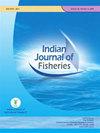南海沿岸三种贵族扇贝(Mimachlamys crassicostata, G. B. Sowerby II, 1842)种群形态变化趋势及其与环境因子的关系
IF 0.3
4区 农林科学
Q4 FISHERIES
引用次数: 0
摘要
本研究旨在评估中国南海沿岸崖州湾、流沙湾和大鹏湾三个养殖扇贝种群(G.B.SowerbyII,1842)的形态特征的空间格局,并确定这些形态特征是否与选定的环境参数有关。通过分类和回归树分析了来自三个地理位置的1353个样本的7个性状的形态比率,以评估其形态变异。此外判别形态特征(壳重与长度、壳重与高度、全重与长度以及壳重与内收肌重量的比值)与九个环境参数(海水温度、盐度、pH、化学需氧量、溶解无机氮、活性磷酸盐、总石油烃、溶解氧和叶绿素a采用混合效应线性模型(LMM)进行评估。结果表明,基于分类和回归树,超过80%的个体可以被分配到他们的收集位置。根据形态变异将个体分配到大鹏湾、崖州湾和流沙湾的采集地点的准确率分别为85.52%、80.30%和80.68%。LMM结果表明,壳重高比和全重长比分别与温度和盐度呈正相关。贝壳重量与内收肌重量与DO浓度呈负相关,表明高DO水平可能是为在食物丰富的沿海海湾养殖的扇贝提供合适环境所必需的。这些结果可能有助于未来的资源管理,包括南中国海粗毛藻的种群识别、生产管理和种群保护。关键词:环境参数,养殖种群,混合效应线性模型,形态特征,种群保护本文章由计算机程序翻译,如有差异,请以英文原文为准。
Morphological trends in three different populations of the noble scallop Mimachlamys crassicostata (G. B. Sowerby II, 1842) along the South China Sea Coast and their relationship to environment factors
This study was carried out to assess the spatial patterns of morphological characteristics of the three cultured populations of the scallop Mimachlamys crassicostata (G. B. Sowerby II, 1842), from Yazhou Bay, Liusha Bay and Mirs Bay along the South China Sea coast and to determine whether any of the morphological characteristics could be related to selected environmental parameters. Morphological ratios of seven traits were analysed by classification and regression tree to evaluate the morphological variations in 1353 samples from three geographic locations. In addition, relationships between discriminatory morphological characteristics (ratios of shell weight to length, shell weight to height, whole weight to length and shell weight to adductor muscle weight) and nine environmental parameters (seawater temperature, salinity, pH, chemical oxygen demand, dissolved inorganic nitrogen, active phosphate, total petroleum hydrocarbons, dissolved oxygen (DO) and chlorophyll a were assessed using mixed-effects linear models (LMMs). Results showed that more than 80% of individuals could be assigned to their collection locations based on the classification and regression tree. The accuracy of assigning individuals to their collection location of Mirs Bay, Yazhou Bay and Liusha Bay based on morphological variation was 85.52, 80.30 and 80.68%, respectively. Results of the LMMs revealed that ratios of shell weight to height and whole weight to length correlated positively with temperature and salinity, respectively. Shell weight to adductor muscle weight correlated negatively with DO concentration, indicating that high DO levels may be necessary to provide a suitable environment for scallops cultured in a food-rich coastal bay. These results may be helpful for future resource management, including stock recognition, productive management and stock conservation of M. crassicostata in the South China Sea.Keywords: Environmental parameters, Cultured population, Mixed-effects linear model, Morphological characteristics, Stock conservation
求助全文
通过发布文献求助,成功后即可免费获取论文全文。
去求助
来源期刊

Indian Journal of Fisheries
FISHERIES-
CiteScore
0.90
自引率
20.00%
发文量
0
审稿时长
6-12 weeks
期刊介绍:
Indian Journal of Fisheries is published quarterly by the Indian Council of Agricultural Research (ICAR), New Delhi. Original contributions in the field of Fish and fisheries science are considered for publication in the Journal. The material submitted must be unpublished and not under consideration for publication elsewhere.
Papers based on research which kills or damages any species, regarded as thratened/ endangered by IUCN crieteria or is as such listed in the Red Data Book appropriate to the geographic area concerned, will not be accepted by the Journal, unless the work has clear conservation objectives.
 求助内容:
求助内容: 应助结果提醒方式:
应助结果提醒方式:


